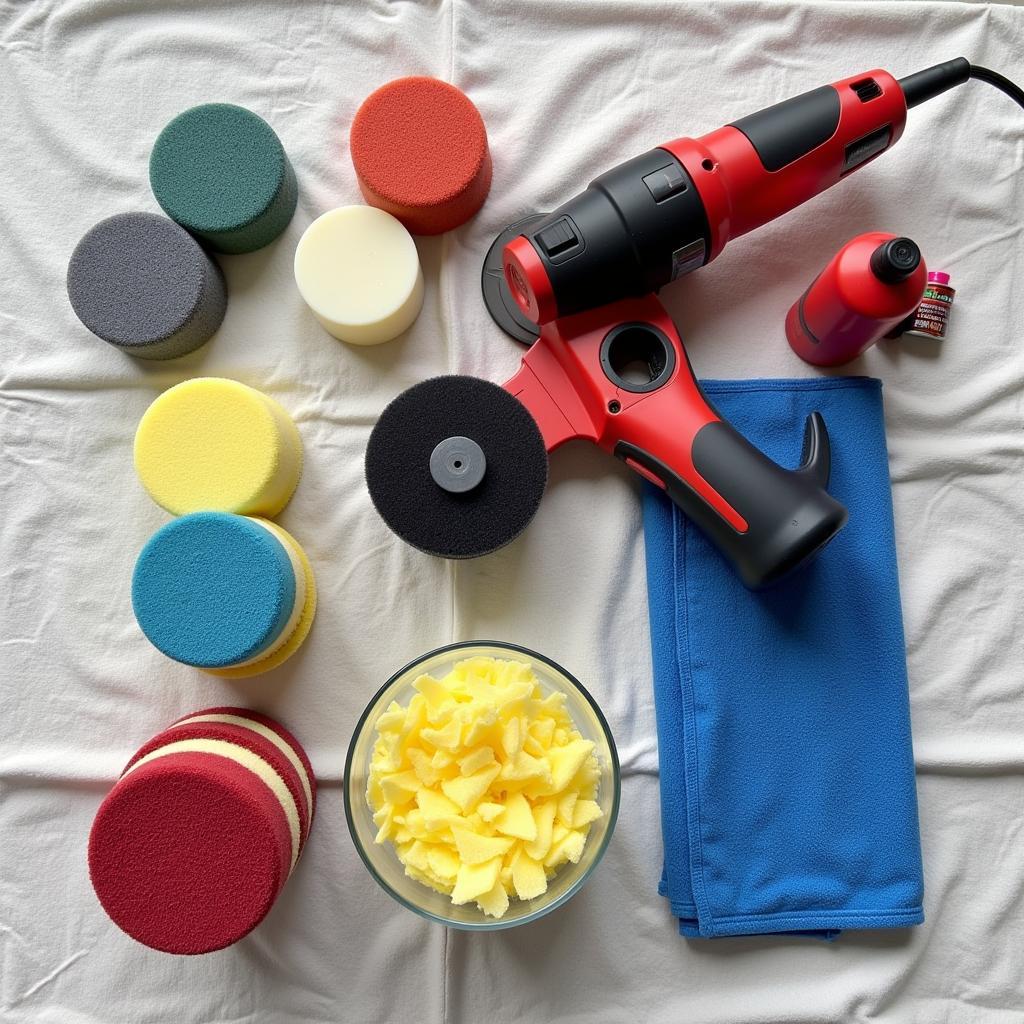Getting a professional-quality respray involves more than just paint and a spray gun. Knowing the right Tools You Need To Respray A Car is crucial for achieving a flawless finish and a long-lasting result. Whether you’re a seasoned pro or a DIY enthusiast, having the correct equipment can make all the difference. This guide will walk you through the essential tools you need to respray a car, from preparation to the final polish. tool for removing paint from car will help you strip the old paint effectively.
Essential Tools for Car Respray Preparation
Proper preparation is the key to a successful respray. Without it, even the best paint job will look amateurish. Here’s what you’ll need:
- Sandpaper: A variety of grits, from coarse to fine, for smoothing imperfections and creating a good surface for the primer.
- Sanding block: Ensures even pressure distribution during sanding, preventing uneven surfaces.
- Masking tape and paper: Protects areas you don’t want to be painted, like windows, trim, and lights.
- Grease and wax remover: Cleans the surface and removes any contaminants that could interfere with paint adhesion.
- Body filler and spreader: Fills dents and scratches, creating a smooth, even surface.
 Car Respray Preparation Tools
Car Respray Preparation Tools
Spraying Equipment for a Perfect Finish
Choosing the right spraying equipment is crucial for achieving a professional-quality finish.
- Spray gun: HVLP (High Volume Low Pressure) spray guns are recommended for their efficiency and reduced overspray.
- Air compressor: Provides a consistent air supply to the spray gun for even paint application.
- Paint thinner/reducer: Thins the paint to the correct viscosity for spraying.
- Mixing cups and sticks: For accurately measuring and mixing paint components.
- Strainers: Removes any impurities from the paint before spraying.
how to determine car paint tools offers valuable insights into selecting the appropriate tools for your specific needs.
Finishing Touches: Polishing and Detailing
Once the paint has dried, the final steps involve polishing and detailing to achieve a flawless shine.
- Polishing compound and pads: Removes any imperfections and creates a smooth, glossy finish.
- Orbital polisher: Provides even pressure and speed for efficient polishing.
- Microfiber towels: For wiping away excess polish and achieving a streak-free shine.
- Wax or sealant: Protects the new paint job and enhances its gloss.
 Car Respray Finishing Tools
Car Respray Finishing Tools
What Tools are Needed to Paint a Car at Home?
While some tools are universal, painting a car at home might not require the same heavy-duty equipment as a professional shop. However, proper safety precautions are essential. Always wear a respirator and work in a well-ventilated area.
how to check if a car is repainted tools can help identify potential issues.
How Do You Prepare a Car for Respraying?
Preparing a car for respraying is a meticulous process involving cleaning, sanding, filling imperfections, and masking. Each step is crucial for a perfect finish. car painting tools uk can offer resources for acquiring these tools.
“Proper surface preparation is 80% of a good paint job,” says renowned auto body expert, John Smith of Smith Auto Restoration. “Don’t rush this process, as it directly impacts the final result.”
Step-by-Step Guide to Respraying Your Car
Respraying a car involves multiple stages, from preparing the surface to applying the final clear coat. Each step requires precision and patience. step by step car painting and tools provides a detailed guide to the process.
“Investing in quality tools is an investment in the final result,” adds Sarah Johnson, a leading automotive paint specialist. “Using the right tools can drastically reduce the time and effort required, while ensuring a professional finish.”
Conclusion
Successfully respraying a car demands the right tools and a thorough understanding of the process. By investing in quality equipment and following the proper procedures, you can achieve a professional-looking finish that will last for years to come. Remember, having the correct tools you need to respray a car is the foundation of a successful paint job.
FAQ
- What type of spray gun is best for beginners?
- How much paint do I need to respray a car?
- What is the ideal temperature for respraying a car?
- How long does it take for car paint to dry?
- What are the common mistakes to avoid when respraying a car?
- How do I choose the right paint color for my car?
- What is the difference between single-stage and two-stage paint?
Common Car Respraying Issues:
- Orange peel: A textured finish resembling an orange peel, often caused by incorrect spray gun settings or improper paint viscosity.
- Fish eyes: Small craters in the paint caused by contaminants like silicone or oil on the surface.
- Runs and sags: Excess paint flowing down the surface, typically caused by applying too much paint or incorrect spraying technique.
- Dust nibs: Small particles of dust embedded in the paint, usually caused by a dusty environment or improper cleaning.
Further Reading and Resources
- Explore more on car paint removal techniques.
- Learn about different types of car paint and their properties.
- Find tips and tricks for achieving a flawless car paint finish.
Need help with your car diagnostic needs? Contact us via WhatsApp: +1(641)206-8880, Email: [email protected] or visit us at 910 Cedar Lane, Chicago, IL 60605, USA. Our customer service team is available 24/7.

Leave a Reply